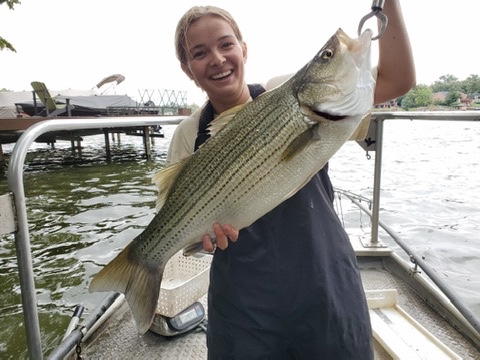Should I Stay, or Should I Go: Tracking partial migration frequency of yellow perch (Perca flavscens)
Studying fish comes with many challenges, and one of the biggest is that they are constantly on the move. Because of this, tracking fish has become a major focus in aquatic science in recent years. With tools like acoustic telemetry, scientists can now monitor fish movement at both fine and large spatial scales. Much like how cell towers use signals to track phones, a network of receivers can record the movements of individual fish over time. We use this technology to study yellow perch in Lake Michigan, a species that is important to both the ecosystem and local fisheries.
Join Anna Hill, a master’s degree student at Purdue University, for an overview of her work tracking fish.

Anna Hill
Featured Scientist
Originally from Chicago, Anna Hill is a master’s degree student at Purdue University co-advised by Tomas Höök and Paris Collingsworth. She completed her undergraduate degree in marine science from the University of Delaware. She has worked as an aquatic technician in both freshwater and marine systems.
- When: November 6, 2025, 11:00 – 12:00 Central Time
- Target audience: Middle school students and up and their educators
- Please pre-register for Zoom-based webinar event
Suggested Pre Webinar Activities
Suggestion 1: Watch the U.S. Fish and Wildlife Service Did You Know? Fish Migrate Too video (2.03 minutes)
Suggestion 2: Watch the European Tracking Network Acoustic Telemetry -how it works and why it is useful video (2:51). Although the focus is on ocean animals, the concept of how acoustic telemetry works within the Great Lakes is the same.
Suggested Post Webinar Activity
Suggestion 1: Surf the Great Lake Acoustic Telemetry Observation System (GLATOS) website to learn more about the equipment and processes used to track fish movement within the Great Lakes. Information about specific tracking projects, maps, photos, videos, and details of how to report a fish tag are also shared.
Suggestion 2: Complete the NOAA Fish Need to Move! Fish Migration lesson plan
Fish need to move! They need to find food, find places to spawn, to hide or rest – and they need aquatic connections between all of these places. Were you aware that over 6-million man-made barriers, in the U.S. alone, keep fish from getting to where they need to go to grow and survive?
Discover why fish migrate, learn about barriers to their migration, and how to make a barrier more fish-friendly.
Suggestion 3: Surf the Wisconsin Department of Natural Resources Fisheries Survey Reports website to learn more about the status of fish populations within Wisconsin including Lake Superior and Lake Michigan.
Not in Wisconsin? Contact your Center for Great Lakes Literacy representative for comparable resources featuring fish survey data within other states and Great Lakes.
Don’t forget to pre-register for the Zoom-based webinar event




